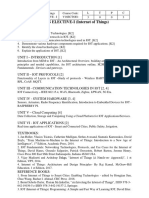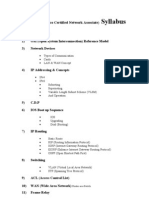An Internet Computing Definition
Uploaded by
Enomaly Cloud ComputingAn Internet Computing Definition
Uploaded by
Enomaly Cloud ComputingInternet Computing
A Find & Replace of the Word "Cloud" with the Word "Internet" based on the Draft NIST
Working definition of Cloud Computing
Note 1: Internet computing is still an evolving paradigm. Its definitions, use cases, underlying
technologies, issues, risks, and benefits will be refined in a spirited debate by the public and
private sectors. These definitions, attributes, and characteristics will evolve and change over
time.
Note 2: The Internet computing industry represents a large ecosystem of many models, vendors,
and market niches. This definition attempts to encompass all of the various Internet approaches.
Definition of Internet Computing:
Internet computing is a model for enabling convenient, on-demand network access to a shared
pool of configurable computing resources (e.g., networks, servers, storage, applications, and
services) that can be rapidly provisioned and released with minimal management effort or
service provider interaction. This Internet model promotes availability and is composed of five
essential characteristics, three service models, and four deployment models.
Essential Characteristics:
On-demand self-service. A consumer can unilaterally provision computing
capabilities, such as server time and network storage, as needed automatically
without requiring human interaction with each service’s provider.
Broad network access. Capabilities are available over the network and accessed
through standard mechanisms that promote use by heterogeneous thin or thick
client platforms (e.g., mobile phones, laptops, and PDAs).
Resource pooling. The provider’s computing resources are pooled to serve
multiple consumers using a multi-tenant model, with different physical and virtual
resources dynamically assigned and reassigned according to consumer demand.
There is a sense of location independence in that the customer generally has no
control or knowledge over the exact location of the provided resources but may be
able to specify location at a higher level of abstraction (e.g., country, state, or
datacenter). Examples of resources include storage, processing, memory, network
bandwidth, and virtual machines.
Rapid elasticity. Capabilities can be rapidly and elastically provisioned, in some
cases automatically, to quickly scale out and rapidly released to quickly scale in.
To the consumer, the capabilities available for provisioning often appear to be
unlimited and can be purchased in any quantity at any time.
Measured Service. Internet systems automatically control and optimize resource
use by leveraging a metering capability at some level of abstraction appropriate to
the type of service (e.g., storage, processing, bandwidth, and active user
accounts). Resource usage can be monitored, controlled, and reported providing
transparency for both the provider and consumer of the utilized service.
Service Models:
Internet Software as a Service (SaaS). The capability provided to the consumer is
to use the provider’s applications running on a Internet infrastructure. The
applications are accessible from various client devices through a thin client
interface such as a Internet browser (e.g., Internet-based email). The consumer
does not manage or control the underlying Internet infrastructure including
network, servers, operating systems, storage, or even individual application
capabilities, with the possible exception of limited user-specific application
configuration settings.
Internet Platform as a Service (PaaS). The capability provided to the consumer is
to deploy onto the Internet infrastructure consumer-created or acquired
applications created using programming languages and tools supported by the
provider. The consumer does not manage or control the underlying Internet
infrastructure including network, servers, operating systems, or storage, but has
control over the deployed applications and possibly application hosting
environment configurations.
Internet Infrastructure as a Service (IaaS). The capability provided to the
consumer is to provision processing, storage, networks, and other fundamental
computing resources where the consumer is able to deploy and run arbitrary
software, which can include operating systems and applications. The consumer
does not manage or control the underlying Internet infrastructure but has control
over operating systems, storage, deployed applications, and possibly limited
control of select networking components (e.g., host firewalls).
Deployment Models:
Private Internet. The Internet infrastructure is operated solely for an organization.
It may be managed by the organization or a third party and may exist on premise
or off premise.
Community Internet. The Internet infrastructure is shared by several organizations
and supports a specific community that has shared concerns (e.g., mission,
security requirements, policy, and compliance considerations). It may be managed
by the organizations or a third party and may exist on premise or off premise.
Public Internet. The Internet infrastructure is made available to the general public
or a large industry group and is owned by an organization selling Internet
services.
Hybrid Internet. The Internet infrastructure is a composition of two or more
Internets (private, community, or public) that remain unique entities but are bound
together by standardized or proprietary technology that enables data and
application portability (e.g., Internet bursting for load-balancing between
Internets).
Note: Internet software takes full advantage of the Internet paradigm by being service
oriented with a focus on statelessness, low coupling, modularity, and semantic
interoperability.
You might also like
- Introduction To Parallel Computing, Second Edition-Ananth Grama, Anshul Gupta, George Karypis, Vipin KumarNo ratings yetIntroduction To Parallel Computing, Second Edition-Ananth Grama, Anshul Gupta, George Karypis, Vipin Kumar2 pages
- The Today and Future of WSN, AI, and IoT: A Compass and Torchbearer for the TechnocratsFrom EverandThe Today and Future of WSN, AI, and IoT: A Compass and Torchbearer for the TechnocratsNo ratings yet
- Top 10 Questions To Ask Before Selecting An Iot PlatformNo ratings yetTop 10 Questions To Ask Before Selecting An Iot Platform5 pages
- Li-Fi (Light Fidelity) The Future Technology in Wireless CommunicationNo ratings yetLi-Fi (Light Fidelity) The Future Technology in Wireless Communication10 pages
- Li-Fi Technology: BY:-Abhishek Kumar B.Tech CSE 4 Year 1743110005100% (1)Li-Fi Technology: BY:-Abhishek Kumar B.Tech CSE 4 Year 174311000523 pages
- Presentation On Li-Fi Technology BY Pratima Kumari Bachelor of Technology in Electronics and CommunicationNo ratings yetPresentation On Li-Fi Technology BY Pratima Kumari Bachelor of Technology in Electronics and Communication20 pages
- Overview of The Internet of Things (Iots) : Spring 2013 Qian Zhang Fytgs, HkustNo ratings yetOverview of The Internet of Things (Iots) : Spring 2013 Qian Zhang Fytgs, Hkust56 pages
- Iot Platforms: Chasing Value in A Maturing Market0% (1)Iot Platforms: Chasing Value in A Maturing Market25 pages
- Article TravelTechTrendsAnalyticsJune2019No ratings yetArticle TravelTechTrendsAnalyticsJune20196 pages
- CAN (Controller Area Network) Data FramesNo ratings yetCAN (Controller Area Network) Data Frames4 pages
- Iot Physical Devices and Endpoints: Bahga & Madisetti, © 2015No ratings yetIot Physical Devices and Endpoints: Bahga & Madisetti, © 201514 pages
- Unit - 1 Systems Modelling, Clustering and Virtualization: 1. Scalable Computing Over The InternetNo ratings yetUnit - 1 Systems Modelling, Clustering and Virtualization: 1. Scalable Computing Over The Internet28 pages
- Download ebooks file Learning Internet of Things 1st Edition Waher all chapters100% (12)Download ebooks file Learning Internet of Things 1st Edition Waher all chapters60 pages
- Difference Between Web of Things and Internet of ThingsNo ratings yetDifference Between Web of Things and Internet of Things8 pages
- IoT Fundamentals 2.0 Lansing CC - June 6No ratings yetIoT Fundamentals 2.0 Lansing CC - June 638 pages
- CS416 - Parallel and Distributed Computing: Lecture # 01No ratings yetCS416 - Parallel and Distributed Computing: Lecture # 0120 pages
- Penetration Testing With Metasploit FrameworkNo ratings yetPenetration Testing With Metasploit Framework16 pages
- Technical Note - Loading FortiGate Firmware Image Using TFTPNo ratings yetTechnical Note - Loading FortiGate Firmware Image Using TFTP4 pages
- TX-NR717: 7.2-Channel Network A/V ReceiverNo ratings yetTX-NR717: 7.2-Channel Network A/V Receiver2 pages
- Data Push From SLD To LMDB - Technical System IDNo ratings yetData Push From SLD To LMDB - Technical System ID11 pages
- OCP - Open Compute Project - vOLT v1.2.1No ratings yetOCP - Open Compute Project - vOLT v1.2.130 pages
- Content Security Policy: Directives of CSPNo ratings yetContent Security Policy: Directives of CSP10 pages
- Security Unplugged !!! - Ovs-Ofctl Commands On OpenFlow 1No ratings yetSecurity Unplugged !!! - Ovs-Ofctl Commands On OpenFlow 13 pages
- SET-317. High Voltage Fuse Blown IndicatorHigh Voltage Fuse Blown Indicator With Voice Based Announcement SystemNo ratings yetSET-317. High Voltage Fuse Blown IndicatorHigh Voltage Fuse Blown Indicator With Voice Based Announcement System3 pages
- Robótica - Manual Robix SoftwareTutorialsNo ratings yetRobótica - Manual Robix SoftwareTutorials19 pages
- EC6612 VLSI DESIGN Laboratory Question SetNo ratings yetEC6612 VLSI DESIGN Laboratory Question Set6 pages
- A-Si TFT LCD Single Chip Driver 240Rgbx320 Resolution and 262K Color DatasheetNo ratings yetA-Si TFT LCD Single Chip Driver 240Rgbx320 Resolution and 262K Color Datasheet112 pages
- Introduction To Optical Character Recognition (OCR)No ratings yetIntroduction To Optical Character Recognition (OCR)29 pages

























































































